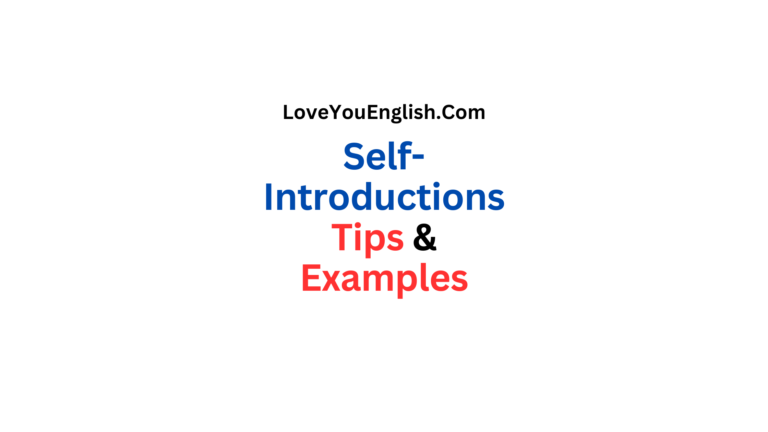How to Understand English Speech Fast
Have you ever listened to someone speaking English and felt like they were racing through their words, leaving you confused and lost?
I’ve been there too, and I know how frustrating it can feel.
Maybe you’re watching a movie, listening to a podcast, or trying to follow a conversation, and the words just blur together.
But here’s the good news: you can learn to understand English speech fast, and it’s not as hard as you might think!
In this post, I’ll share simple, practical tips that helped me—and will help you—catch every word, no matter how quickly someone talks.
Let’s dive in and make English feel easier, step by step.
Why Is English Speech So Hard to Understand?
First, let’s talk about why English can feel so fast.
When native speakers talk, they don’t say every word slowly or clearly like in a textbook.
They blend words together, skip sounds, and use shortcuts. For example, “going to” becomes “gonna,” or “what are you” turns into “whatcha.” It’s not your fault if this feels overwhelming—it’s just how the language works!
Plus, everyone speaks at different speeds, and accents add another layer of challenge.
But don’t worry. Understanding fast English speech is a skill you can build. It’s like training your ears and brain to keep up.
With practice, you’ll start hearing the words you used to miss. Let’s break it down into easy steps you can start today.
Step 1: Start with What You Already Know
Here’s a secret: you don’t need to understand every single word to get the idea. When I started learning to follow fast English, I focused on catching the big words—the ones that carry the meaning—like “dog,” “run,” or “happy.” Little words like “the” or “and”? I let them slide at first. Your brain will fill in the gaps as you get better.
Try this: watch a short English video you’ve seen before, like a cartoon or a movie scene you love. Since you already know the story, your brain won’t panic. Listen for the key words and see how much you can pick up. It’s like a warm-up for your ears!
Step 2: Slow It Down (Yes, You Can Cheat a Little)
When I was struggling with fast English, I discovered a game-changer: slowing down videos or audio. Apps like YouTube or Netflix let you change the speed. Set it to 0.75x or even 0.5x at first. Suddenly, those blurry words become clear! You’ll hear how “I’m gonna” is really “I am going to” stretched out.
Here’s what I did: I’d listen to a clip slowly a few times, then speed it back up to normal. It was like training wheels on a bike—after a while, I didn’t need the slow version anymore. Pick a podcast, song, or show you like, and try this trick. You’ll be amazed how fast you improve.
Step 3: Copy the Rhythm of English
English has a beat, like music. Some words get stressed (said louder), and others get squished together. For example, in “I WANT to GO,” “want” and “go” are strong, while “to” is quick and soft. Native speakers don’t even think about this—they just feel it. But you can learn it too!
Here’s a fun way to practice: pick a sentence from a movie, like “I’ll be back” from Terminator. Say it out loud, over and over, copying the actor’s speed and rhythm. Feel how the words flow together. I used to do this in front of the mirror, pretending I was in the movie—it’s silly, but it works! The more you mimic, the more your ears tune into that fast English flow.
Step 4: Build Your Word Radar
Sometimes English feels fast because you don’t know the words yet. Imagine hearing “cat” versus “catastrophe”—if you only know “cat,” the longer word zooms by like a rocket. The more words you recognize, the easier it is to keep up.
I started with a simple habit: every day, I’d learn five new words or phrases I heard in a show or song. I’d write them down, say them aloud, and listen for them again. For example, after hearing “awesome” in a video, I’d notice it popping up everywhere! Over time, my “word radar” got sharper, and fast speech didn’t scare me as much.
Try this: next time you hear a word you don’t know, pause and look it up. Then listen again. It’s like adding tools to your toolbox—one by one, you’ll catch more.
Step 5: Listen to Real People Talking
Textbooks are great, but real English is messy and fast. That’s why I started listening to real conversations—podcasts, YouTube vlogs, even eavesdropping at the coffee shop (don’t judge me!). The more I heard regular people talk, the more I got used to the speed.
Pick something fun to listen to. Love cooking? Find a cooking podcast. Crazy about sports? Watch game highlights with commentary. I used to listen to a podcast about funny pet stories—half the time I was laughing, but I was also training my ears. Start with 5-10 minutes a day, and soon you’ll handle longer chunks without breaking a sweat.
Step 6: Don’t Be Afraid of Accents
Accents can make English sound like a whole new language. A British “water” sounds different from an American “water,” and don’t get me started on Australian slang! But here’s the thing: you don’t need to master every accent—just get comfortable with a few.
I picked one accent to focus on first (American, because I loved Friends). I’d watch episodes and repeat lines like “How you doin’?” in my best Joey voice. Once I got the hang of it, I tried British shows like Sherlock. Start with what you enjoy, and let your ears adjust. Accents won’t feel so fast once they’re familiar.
Step 7: Practice with Friends (or Yourself!)
Nothing beats talking to real people. When I couldn’t find someone to chat with, I’d talk to myself—seriously! I’d pretend I was ordering food or explaining my day, saying things fast like a native speaker. It felt weird at first, but it trained my brain to think and hear quickly.
If you have a friend who speaks English, ask them to talk at normal speed. Tell them you’re practicing, so they don’t slow down for you. Even if you miss half of it, keep going—your ears will catch up. I once asked my cousin to ramble about his dog, and I just nodded until I started hearing words like “bark” and “treat.” It’s progress, not perfection!
Step 8: Watch Without Subtitles (But Be Smart About It)
Subtitles are a crutch—I get it, I loved them too. But relying on them keeps your eyes busy and your ears lazy. I made a rule: watch with subtitles off for five minutes, then turn them on to check what I missed. It was hard, but it forced my brain to listen harder.
Pick something easy first, like a kids’ show (Peppa Pig is my guilty pleasure). The words are simple, and the pace isn’t crazy. As you get better, try tougher stuff like news clips or fast-talking comedians. You’ll feel proud when you catch a full sentence without help!
Step 9: Stay Relaxed and Patient
Here’s a big one: don’t stress out. When I’d panic about missing words, my brain would freeze, and I’d understand less. Fast English isn’t a test—it’s a puzzle to enjoy. If you don’t get it all, that’s okay. You’re learning, not failing.
Take breaks when you need them. I’d listen for 20 minutes, then sip some tea and relax. Over time, I noticed I could handle more without feeling tired. Be kind to yourself—you’re doing awesome just by trying.
Step 10: Make It a Daily Habit
Like anything, practice makes it easier. I didn’t get good at understanding fast English overnight—it took weeks of little efforts. I’d listen to a song in the morning, watch a clip at lunch, and chat with myself before bed. Small steps add up fast.
Set a goal: 15 minutes a day of listening to real English. Use your phone, TV, or even the radio. Mix it up so it stays fun. Before you know it, you’ll hear someone blabbing away in English, and instead of panicking, you’ll think, “Hey, I’ve got this!”
Bonus Tips to Keep You Going
- Sing Along: Songs are fast and catchy. Try karaoke with English hits—your ears and mouth will thank you.
- Repeat, Repeat, Repeat: Hear a tricky line? Replay it five times until it clicks.
- Laugh at Mistakes: I once thought “piece of cake” meant actual cake. It’s okay to mess up—it’s how you learn!
You’re Closer Than You Think
Understanding fast English speech isn’t magic—it’s practice, patience, and a little fun.
Start with these steps, and you’ll notice the words slowing down in your head, even if the speaker’s still zooming.
I went from clueless to confident, and you will too.
Imagine watching your favorite show, chatting with a friend, or traveling—all without that “lost” feeling. It’s worth it, I promise.
So, what’s your next step?
Grab a video, pick a song, or just listen to someone talk.
You’ve got the tools now—go use them!
And hey, let me know how it goes—I’d love to hear your story.
Keep at it, and soon, fast English won’t feel fast anymore. You’ve got this!
FAQs About Understanding Fast English Speech
1. How long will it take to understand fast English speech?
It varies, but with daily practice (15-30 minutes), you could notice improvement in a few weeks. After a few months, fast speech will feel much easier. Consistency is key!
2. What if I don’t have anyone to practice speaking with?
No problem! You can practice solo by mimicking videos, talking to yourself, or repeating lines from shows. Listening to podcasts or vlogs also trains your ears without needing a partner.
3. Should I focus on one English accent or try them all?
Start with one accent that’s common in what you listen to, like American or British. Once you’re comfortable, explore others. It’s easier to master one at a time, but mixing it up later adds variety.
4. What if I still need subtitles after trying without them?
That’s okay! Use subtitles as a tool, not a crutch. Try watching five minutes without them, then check with subtitles to see what you missed. Gradually increase the no-subtitle time as you improve.
5. How do I pick the right videos or podcasts to practice with?
Choose something you enjoy—movies, cooking shows, sports commentary, or funny podcasts. Start with clear speakers or slower content (like kids’ shows) and move to faster stuff as you get better.
6. What if I feel overwhelmed by fast speech?
Take it slow and don’t stress. Break listening into short chunks (5-10 minutes) and focus on catching key words, not everything. Slow down videos if needed—it’s like training wheels for your ears.
7. Can apps or tools help me understand fast English?
Yes! Apps like YouTube (for speed control), Audible (for audiobooks), or FluentU (for learning with videos) are great. Free podcasts or language apps like BBC Learning English can also build your listening skills.
8. What if I keep missing words even after practicing?
It’s normal! Focus on the main ideas first, not every word. Keep building your vocabulary—learning common phrases like “gonna” or “whatcha” helps. The more you listen, the more you’ll catch.
9. Is it okay to practice with non-native English speakers?
Sure, it can help, especially for casual conversation. But mix in native speaker content (shows, podcasts) to get used to natural speed and slang. Both are valuable for different reasons.
10. Where can I find more resources to practice listening?
Check YouTube for English vlogs or tutorials, Spotify for podcasts (try “The English We Speak” or “6 Minute English”), or Netflix for shows with adjustable speeds. Online forums like Reddit’s r/EnglishLearning also share great tips.
More topics:
- How to Measure Your Progress in English: A Simple Guide
- How to Use Music to Learn English
- How to Use Flashcards for Vocabulary Building
- Best Resources to Learn English
- Best Resources to Learn English Grammar







